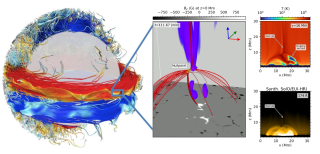Bibcode
Joshi, Reetika; Aulanier, Guillaume; Radcliffe, Alice; Rouppe van der Voort, Luc; Pariat, Etienne; Nóbrega-Siverio, Daniel; Schmieder, Brigitte
Bibliographical reference
Astronomy and Astrophysics
Advertised on:
7
2024
Journal
Citations
5
Refereed citations
4
Description
Context. Solar jets are collimated plasma flows moving along magnetic field lines and are accelerated at low altitude following magnetic reconnection. Several of them originate from anemone-shaped low-lying arcades, and the most impulsive ones tend to be relatively wider and display untwisting motions.
Aims: We aim to establish typical behaviours and observational signatures in the low atmosphere that can occur in response to the coronal development of such impulsive jets.
Methods: We analysed an observed solar jet associated with a circular flare ribbon using high-resolution observations from SST coordinated with IRIS and SDO. We related specifically identified features with those developing in a generic 3D line-tied numerical simulation of reconnection-driven jets performed with the ARMS code.
Results: We identified three features in the SST observations: the formation of a hook along the circular ribbon, the gradual widening of the jet through the apparent displacement of its kinked edge towards (and not away) from the presumed reconnection site, and the falling back of some of the jet plasma towards a footpoint offset from that of the jet itself. The 3D numerical simulation naturally accounts for these features, which were not imposed a priori. Our analyses allowed us to interpret them in the context of the 3D geometry of the asymmetric swirled-anemone loops and their sequences of reconnection with ambient coronal loops.
Conclusions: Given the relatively simple conditions in which the observed jet occurred, together with the generic nature of the simulation that comprised minimum assumptions, we predict that the specific features that we identified and interpreted are probably typical of every impulsive jet.
Aims: We aim to establish typical behaviours and observational signatures in the low atmosphere that can occur in response to the coronal development of such impulsive jets.
Methods: We analysed an observed solar jet associated with a circular flare ribbon using high-resolution observations from SST coordinated with IRIS and SDO. We related specifically identified features with those developing in a generic 3D line-tied numerical simulation of reconnection-driven jets performed with the ARMS code.
Results: We identified three features in the SST observations: the formation of a hook along the circular ribbon, the gradual widening of the jet through the apparent displacement of its kinked edge towards (and not away) from the presumed reconnection site, and the falling back of some of the jet plasma towards a footpoint offset from that of the jet itself. The 3D numerical simulation naturally accounts for these features, which were not imposed a priori. Our analyses allowed us to interpret them in the context of the 3D geometry of the asymmetric swirled-anemone loops and their sequences of reconnection with ambient coronal loops.
Conclusions: Given the relatively simple conditions in which the observed jet occurred, together with the generic nature of the simulation that comprised minimum assumptions, we predict that the specific features that we identified and interpreted are probably typical of every impulsive jet.
Movies associated to Fig. 2 are available at https://www.aanda.org.
Related projects

The Whole Sun Project: Untangling the complex physical mechanisms behind our eruptive star and its twins
The Sun is a magnetically active star with violent eruptions that can hit Earth´s magnetosphere and cause important perturbations in our technology-dependent society. The objective of the Whole Sun project is to tackle in a coherent way for the first time key questions in Solar Physics that involve as a whole the solar interior and the atmosphere
Fernando
Moreno Insertis

Numerical Simulation of Astrophysical Processes
Numerical simulation through complex computer codes has been a fundamental tool in physics and technology research for decades. The rapid growth of computing capabilities, coupled with significant advances in numerical mathematics, has made this branch of research accessible to medium-sized research centers, bridging the gap between theoretical and
Daniel Elías
Nóbrega Siverio